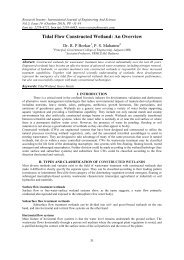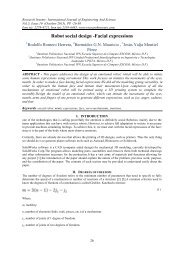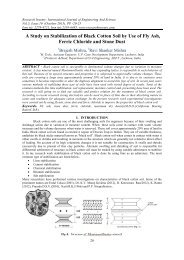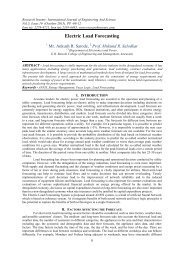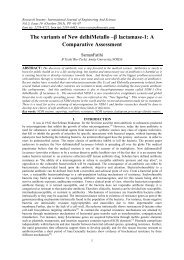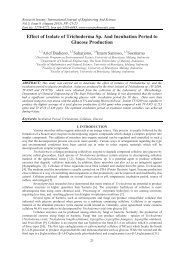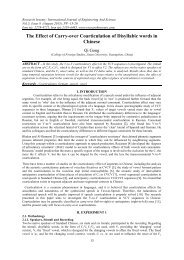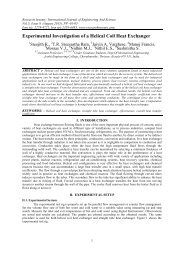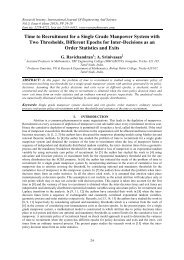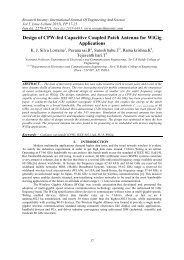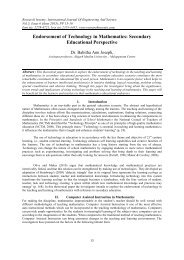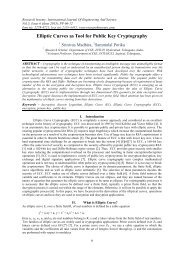Enhancement the Strength of Conventional Concrete by using Nylon Fibre
Create successful ePaper yourself
Turn your PDF publications into a flip-book with our unique Google optimized e-Paper software.
Research Inventy: International Journal Of Engineering And Science<br />
Vol.5, Issue 2 (February 2015), PP 56-59<br />
Issn (e): 2278-4721, Issn (p):2319-6483, www.researchinventy.com<br />
<strong>Enhancement</strong> <strong>the</strong> <strong>Strength</strong> <strong>of</strong> <strong>Conventional</strong> <strong>Concrete</strong> <strong>by</strong> <strong>using</strong><br />
<strong>Nylon</strong> <strong>Fibre</strong><br />
Jaya Saxena 1 , Pr<strong>of</strong>. Anil Saxena 2<br />
1 .Rajiv Gandhi proudyogiki University , Civil engineering M-tech in Construction Technology and<br />
management, Bhopal M.P.<br />
2 .Pr<strong>of</strong>fessor ,Lakshmi Narayan College , Bhopal M.P.<br />
Abstract : <strong>Fibre</strong> can be defined as a small piece <strong>of</strong> reinforcing material possessing certain dimensional<br />
characteristics. The most important parameter describing a fibre is its Aspect ratio. “Aspect Ratio” is <strong>the</strong> length<br />
<strong>of</strong> fibre divided <strong>by</strong> an equivalent diameter <strong>of</strong> <strong>the</strong> fibre. The properties <strong>of</strong> fibre reinforced concrete are very much<br />
affected <strong>by</strong> <strong>the</strong> type <strong>of</strong> fibre. The properties <strong>of</strong> fibre reinforced concrete are very much affected <strong>by</strong> <strong>the</strong> type <strong>of</strong><br />
fibre. <strong>Fibre</strong>s are secondary reinforced material and acts as crack arrester. Prevention <strong>of</strong> propagation <strong>of</strong> cracks<br />
originating from internal flaws can result in improvements in static and dynamic properties <strong>of</strong> matrix. <strong>Fibre</strong><br />
reinforced cement and concrete materials (FRC) have been developed progressively since <strong>the</strong> early work <strong>by</strong><br />
Romualdi and Batson in <strong>the</strong> 1960s. By <strong>the</strong> 1990s, a wide range <strong>of</strong> fibre composites and FRC products were<br />
commercially available and novel manufacturing techniques were developed for use with high fibre content. In<br />
parallel with <strong>the</strong> commercial development <strong>of</strong> FRC materials and products, an extensive research programme<br />
was undertaken to quantify <strong>the</strong> enhanced properties <strong>of</strong> FRC materials and more specifically to allow<br />
comparisons to be made between various types <strong>of</strong> fibres.<br />
Keywords: <strong>Fibre</strong> Reinforced <strong>Concrete</strong>, <strong>Nylon</strong> <strong>Fibre</strong>, <strong>Conventional</strong> concrete.<br />
I. INTRODUCTION<br />
<strong>Fibre</strong> reinforced concrete (FRC) is a composite material consisting <strong>of</strong> cement, sand, coarse aggregate,<br />
water and fibres. In this composite material, short discrete fibres are randomly distributed throughout <strong>the</strong><br />
concrete mass. The behavioral efficiency <strong>of</strong> this composite material is far superior to that <strong>of</strong> plain concrete and<br />
many o<strong>the</strong>r construction materials <strong>of</strong> equal cost. Due to this benefit, <strong>the</strong> use <strong>of</strong> FRC has steadily increased<br />
during <strong>the</strong> last two decades and its current field <strong>of</strong> application includes: airport and highway pavements,<br />
earthquake-resistant and explosive-resistant structures, mine and tunnel linings, bridge deck overlays, hydraulic<br />
structures, rock-slope stabilization, etc. Extensive research work on FRC has established that addition <strong>of</strong><br />
various types <strong>of</strong> fibres such as metallic and non-metallic fibre like (steel), glass, syn<strong>the</strong>tic, and carbon, in plain<br />
concrete improves strength, toughness, ductility, post-cracking resistance, etc. These dramix hooked end steel<br />
fibres and polypropylene fibres can effectively be used for making high-strength HFRC after exploring <strong>the</strong>ir<br />
suitability. In this investigation, <strong>the</strong>refore, an attempt has been made to study <strong>the</strong> feasibility <strong>of</strong> <strong>using</strong> two kinds<br />
<strong>of</strong> fibres for making HFRC. Cementitious materials are generally quite brittle, with relatively low strength and<br />
strain capacity under tension. Hence a hand-laid steel bar reinforcement is usually necessary to increase tensile<br />
strength. For low reinforcement levels, <strong>the</strong> partial or even complete replacement <strong>of</strong> this conventional<br />
reinforcement <strong>by</strong> fibers is an advantageous alternative. For special applications, highly ductile fiber reinforced<br />
cementitious materials like ultra-high performance concrete or engineered cementitious compo- sites have been<br />
developed. <strong>Fibre</strong>s may also be applied to control <strong>the</strong> detrimental effects <strong>of</strong> shrinkage. A significant reduction in<br />
crack width and crack spacing is possible, especially at early ages. They possess a high tensile strength and a<br />
high elastic modulus <strong>the</strong>se are available at relatively low costs. The high modulus, which is much higher than<br />
<strong>the</strong> one <strong>of</strong> concrete or cement paste prevents <strong>the</strong> fibre from stretching or cross contraction upon load, which<br />
hence leads to a good fibre–matrix bond and smaller crack widths. A variety <strong>of</strong> tests have been performed to<br />
determine <strong>the</strong> actual characteristics and advantages <strong>of</strong> tuberous materials. The addition <strong>of</strong> steel fibres helps in<br />
converting <strong>the</strong> brittle characteristics to ductile ones. To faster <strong>the</strong> compressive strength without sacrificing <strong>the</strong><br />
ductility, a strategy adopted is to add discrete steel fibres as reinforcement in concrete. It is obvious that <strong>the</strong><br />
behaviour <strong>of</strong> HFRC depends on <strong>the</strong> orientations, distributions, aspect ratios, geometrical shapes and mechanical<br />
properties <strong>of</strong> fibres in concrete mixtures. The orientations and distributions <strong>of</strong> fibre affect <strong>the</strong> properties <strong>of</strong> FRC<br />
such as toughness, strength, ductility and crack width.<br />
56
<strong>Enhancement</strong> <strong>the</strong> <strong>Strength</strong> Of <strong>Conventional</strong>…<br />
II. SPECIFICATION OF MATERIAL USED<br />
A) <strong>Nylon</strong> Fiber - <strong>Nylon</strong> is smooth, light weight and high strength.<br />
a) <strong>Strength</strong>: <strong>Nylon</strong> has good tenacity and <strong>the</strong> strength is not lost with age. <strong>Nylon</strong> has a high strength to<br />
weight ratio. It is one <strong>of</strong> <strong>the</strong> lightest textile fibres is at <strong>the</strong> same time also one <strong>of</strong> <strong>the</strong> strongest. <strong>Nylon</strong> has<br />
excellent abrasion resistance.<br />
b) Elasticity: <strong>Nylon</strong> has good elasticity which makes it much suitable for <strong>the</strong> apparel purposes. The excellent<br />
elasticity would mean that <strong>the</strong> nylon materials return to <strong>the</strong>ir original length and shreds <strong>the</strong> wrinkles or<br />
creases. <strong>Nylon</strong> like o<strong>the</strong>r fibres has its own limit <strong>of</strong> elasticity.<br />
2.1 <strong>Nylon</strong> Fiber<br />
<strong>Nylon</strong> is a generic name that identifies a family <strong>of</strong> polymers. <strong>Nylon</strong> fiber’s properties are imparted <strong>by</strong> <strong>the</strong><br />
base polymer type, addition <strong>of</strong> different levels <strong>of</strong> additive, manufacturing conditions and fiber dimensions.<br />
Currently only two types <strong>of</strong> nylon fiber are marketed for concrete. <strong>Nylon</strong> is heat stable, hydrophilic, relatively<br />
inert and resistant to a wide variety <strong>of</strong> materials. <strong>Nylon</strong> is particularly effective in imparting impact resistance<br />
and flexural toughness and sustaining and increasing <strong>the</strong> load carrying capacity <strong>of</strong> concrete following first crack.<br />
The NYLON FIBERS are made with 100% purity provided as a filament fiber for secondary<br />
reinforcement <strong>of</strong> concrete. The three-dimensional reinforcement provided <strong>by</strong> <strong>the</strong> nylon fibers intercepts <strong>the</strong><br />
fissures that occur during plastic retraction <strong>of</strong> <strong>the</strong> concrete in <strong>the</strong> stage when micro-fissures occur without fibers.<br />
The nylon fibers also reinforce <strong>the</strong> impact resistance.<br />
The principal application <strong>of</strong> NYLON FIBERS is for reduction <strong>of</strong> fissuring, due to plastic contraction <strong>of</strong><br />
concrete, including: slabs, elevated decks, pavements, sports arenas, roads, parking lots, façades, etc. O<strong>the</strong>r<br />
applications include repair <strong>of</strong> pre-cast walls, pools and mortars for walls.<br />
III. LIMITATIONS OF APPLICATION<br />
The NYLON FIBERS should not be used with structural elements <strong>of</strong> concrete but just with secondary<br />
reinforcement .The engineer should confirm that if <strong>the</strong> steel screen is being used for structural capacity; if so,<br />
<strong>the</strong>n <strong>the</strong> NYLON FIBERS can be added, but not as a substitute for <strong>the</strong> steel screens. When used in elevated<br />
slabs <strong>the</strong> nylon fibers, if used <strong>by</strong> <strong>the</strong>mselves, cannot guarantee <strong>the</strong> absence <strong>of</strong> fissures. The steel screen should<br />
be incorporated toge<strong>the</strong>r with <strong>the</strong> fibers.<br />
IV. BENEFIT OF NYLON FIBERS :-<br />
Improve mix cohesion over long distances<br />
<br />
<br />
<br />
<br />
Improve freeze-thaw resistance<br />
Improve resistance to explosive spalling in case <strong>of</strong> a severe fire<br />
Improve impact resistance<br />
Increase resistance to plastic shrinkage during curing<br />
V DISCOVERY OF NYLON:–<br />
An organic chemist, Wallace Cara<strong>the</strong>rs produced nylon, a very commonly found polymer, in <strong>the</strong> year<br />
1935. However, until 1937, <strong>the</strong> discovery remained unpatented and in <strong>the</strong> year 1938, <strong>the</strong> discovery <strong>of</strong> nylon was<br />
announced. The chemical name <strong>of</strong> nylon is poly hexa-methylene adipamide. It took seven years for <strong>the</strong> chemist<br />
to accomplish success on this project. He also discovered <strong>the</strong> fact that <strong>the</strong> liquid form <strong>of</strong> <strong>the</strong> polymer solidified<br />
quickly when it was blown through <strong>the</strong> nozzles that were ultra-thin.<br />
57
<strong>Enhancement</strong> <strong>the</strong> <strong>Strength</strong> Of <strong>Conventional</strong>…<br />
VI. MATERIALS USED<br />
The main objective <strong>of</strong> test program is to study strength characteristics <strong>of</strong> concrete with adding different<br />
percentage <strong>of</strong> Steel and polypropylene fiber. The main parameters that were studied include compressive<br />
strength, Split tensile test and flexural test. The materials used for casting concrete samples, along with <strong>the</strong><br />
tested results are described as under.<br />
A) Cement:-<br />
Cement is a fine, grey powder. It is mixed with water and materials such as sand, gravel, crushed stone<br />
to make concrete. The cement and water form a paste that and binds <strong>the</strong> o<strong>the</strong>r materials toge<strong>the</strong>r as <strong>the</strong> concrete<br />
hardens. The ordinary cement contains two basic ingredients namely argillaceous and calcareous. In argillaceous<br />
materials clay predominates and in calcareous materials calcium carbonate predominates. In <strong>the</strong> present work<br />
Ultra-Tech 43 grade (OPC) Cement was used for casting cubes for all concrete mixes.<br />
The cement was Uniform colour i.e. grey with a light greenish shade and was free from any hard lumps.<br />
Ordinary Portland cement Ultra-Tech 43 grade (OPC) was used. Tests were carried out on various physical<br />
properties <strong>of</strong> cement and <strong>the</strong> results are shown in Table.<br />
B) Coarse Aggregate:-<br />
Crushed granite stones obtained from local queries were used as coarse aggregate. The maximum size<br />
<strong>of</strong> coarse aggregate used was 20 mm. The properties <strong>of</strong> coarse aggregate were determined <strong>by</strong> conducting tests.<br />
The broken stone is generally used as coarse aggregate. The aggregates were washed to remove dust and dirt<br />
and were dried to surface dry condition. The aggregates are tested as per IS 383: 1970.<br />
C) Properties <strong>of</strong> Fine Aggregates:-<br />
Natural river sand was used as fine aggregate. The properties <strong>of</strong> sand were determined. The results are<br />
shown in Table.3.The results obtained from sieve analysis. The results indicate that <strong>the</strong> sand conforms to Zone<br />
II.<br />
D) Water:-<br />
Portable water available in <strong>the</strong> college campus free from salts was used for casting and curing <strong>of</strong><br />
concrete as per IS: 456 – 2000 recommendations.<br />
E) Fly Ash:-Fly ash used in conventional concrete <strong>by</strong> 10%, 20% & 30% replaced <strong>by</strong> cement sample.<br />
Fly ash is a rich cementations industrial waste which has <strong>the</strong> great potential to substitute Portland<br />
cement, a major producer <strong>of</strong> CO2 and <strong>the</strong>re<strong>by</strong> decreasing greenhouse gas emissions. The production <strong>of</strong> fly ash<br />
in India is likely to be more than 175 million tons <strong>by</strong> <strong>the</strong> year 2012.Though due to lot <strong>of</strong> efforts <strong>by</strong> State and<br />
Central Government <strong>the</strong> utilization <strong>of</strong> fly ash has gone beyond 50%, still a lot has to be done for full utilization<br />
<strong>of</strong> this precious wealth from <strong>the</strong> waste. The eastern state <strong>of</strong> Orissa in India has a large coal deposit thus<br />
facilitating <strong>the</strong>rmal power plants and producing more and more fly ash day <strong>by</strong> day.<br />
Coal-based <strong>the</strong>rmal power installations in India contribute about 65% <strong>of</strong> <strong>the</strong> total installed capacity for<br />
electricity generation. In terms <strong>of</strong> energy supply <strong>the</strong> contribution is even higher, as <strong>the</strong>se plants meet base load<br />
requirements. In order to meet <strong>the</strong> growing energy demand <strong>of</strong> <strong>the</strong> country, coal-based <strong>the</strong>rmal power generation<br />
is expected to play a dominant role in <strong>the</strong> future as well, since coal reserves in India are expected to last for<br />
more than 100 years. Indian coals have very high ash content. The ash content <strong>of</strong> coal used <strong>by</strong> <strong>the</strong>rmal power<br />
plants in India varies between 25 and 45%. However, coal with an ash content <strong>of</strong> around 40% is predominantly<br />
used in India for <strong>the</strong>rmal power generation. As a consequence, a huge amount <strong>of</strong> fly ash is generated in <strong>the</strong>rmal<br />
power plants, ca<strong>using</strong> several disposal-related problems. In spite <strong>of</strong> initiatives taken <strong>by</strong> <strong>the</strong> government, several<br />
non-governmental organizations and research and development organizations for fly ash utilization, <strong>the</strong> level <strong>of</strong><br />
fly ash utilization in <strong>the</strong> country was estimated to be less than 10% prior to 1996-97. Globally, less than 25% <strong>of</strong><br />
<strong>the</strong> total annual fly ash produced in <strong>the</strong> world is utilized.<br />
(a) Definition <strong>of</strong> FLY ASH:-<br />
Fly-ash is defined in Cement and <strong>Concrete</strong> Terminology (ACI Committee 116) as “<strong>the</strong> finely<br />
divided residue resulting from <strong>the</strong> combustion <strong>of</strong> ground or powdered coal, which is transported from <strong>the</strong><br />
firebox through <strong>the</strong> boiler <strong>by</strong> flue gases.” Fly-ash is a <strong>by</strong>-product <strong>of</strong> coal-fired electric generating plants.<br />
“ Fine particulate ash sent up <strong>by</strong> <strong>the</strong> combustion <strong>of</strong> a solid fuel, such as coal, and discharged as an<br />
airborne emission or recovered as a <strong>by</strong>-product for various commercial uses.”<br />
58
<strong>Enhancement</strong> <strong>the</strong> <strong>Strength</strong> Of <strong>Conventional</strong>…<br />
(b) Concept <strong>of</strong> Fly Ash introduced in Construction:-<br />
Fly ash is a group <strong>of</strong> materials that can vary significantly in composition. It is residue left from<br />
burning coal, which is collected on an electrostatic precipitator or in a bag-house. It mixes with flue gases that<br />
result when powdered coal is used to produce electric power. Since <strong>the</strong> oil crisis <strong>of</strong> <strong>the</strong> 1970s, <strong>the</strong> use <strong>of</strong> coal has<br />
increased. In 1992, 460 million metric tons <strong>of</strong> coal ash were produced worldwide. About 10 percent <strong>of</strong> this was<br />
produced as fly ash in <strong>the</strong> United States. In 1996, more than 7 million metric tons were used in concrete in <strong>the</strong><br />
U.S. Economically, it makes sense to use as much <strong>of</strong> this low-cost ash as possible, especially if it can be used in<br />
concrete as a substitute for cement. Coal is <strong>the</strong> product <strong>of</strong> millions <strong>of</strong> years <strong>of</strong> decomposing vegetable matter<br />
under pressure, and its chemical composition is erratic. In addition, electric companies optimize power<br />
production from coal <strong>using</strong> additives such as flue-gas conditioners, sodium sulfate, oil, and o<strong>the</strong>r additives to<br />
control corrosion, emissions, and fouling. The resulting fly ash can have a variable composition and contain<br />
several additives as well as products from in-complete combustion.<br />
(g) Properties Of Fly Ash:-<br />
1) Fineness: The fineness <strong>of</strong> fly ash is important because it affects <strong>the</strong> rate <strong>of</strong> pozzolanic activity<br />
and <strong>the</strong> workability <strong>of</strong> <strong>the</strong> concrete. Specifications require a minimum <strong>of</strong> 66 percent passing <strong>the</strong> 0.044<br />
mm (No. 325) sieve.<br />
2) Specific gravity: Although specific gravity does not directly affect concrete quality, it has value in<br />
identifying changes in o<strong>the</strong>r fly ash characteristics. It should be checked regularly as a quality control<br />
measure, and correlated to o<strong>the</strong>r characteristics <strong>of</strong> fly ash that may be fluctuating.<br />
3) Chemical composition:The reactive aluminosilicate and calcium aluminosilicate components <strong>of</strong> fly ash<br />
are routinely represented in <strong>the</strong>ir oxide nomenclatures such as silicon dioxide, aluminium oxide and<br />
calcium oxide. The variability <strong>of</strong> <strong>the</strong> chemical composition is checked regularly as a quality control<br />
measure. The aluminosilicate components react with calcium hydroxide to produce additional<br />
cementitious materials. Fly ashes tend to contribute to concrete strength at a faster rate when <strong>the</strong>se<br />
components are present in finer fractions <strong>of</strong> <strong>the</strong> fly ash.<br />
Sulphur trioxide content is limited to five percent, as greater amounts have been shown to<br />
increase mortar bar expansion. Available alkalis in most ashes are less than <strong>the</strong> specification limit <strong>of</strong> 1.5<br />
percent. Contents greater than this may contribute to alkali-aggregate expansion problems.<br />
3.7.5 (d) Fly Ash <strong>Concrete</strong><br />
Fly ash is one <strong>of</strong> <strong>the</strong> naturally-occurring products <strong>of</strong> <strong>the</strong> coal combustion process and is a residue that is<br />
nearly identical to volcanic ash. It is considered a pozzolanic material, which means that when mixed with<br />
calcium hydroxide, it has many <strong>of</strong> <strong>the</strong> same properties as cement. There are a number <strong>of</strong> well documented<br />
benefits from replacing a portion <strong>of</strong> <strong>the</strong> cement with fly ash to create a cementitious material that is <strong>the</strong>n used<br />
along with aggregates, water and various o<strong>the</strong>r components, to produce concrete for roads and bridges. Some <strong>of</strong><br />
<strong>the</strong> benefits <strong>of</strong> <strong>using</strong> fly ash concrete include:<br />
• Fly ash concrete is stronger. Over <strong>the</strong> long run, fly ash concrete has increased strength, which means<br />
<strong>the</strong>re is less wear and tear on <strong>the</strong> roadway from heavy trucks and vehicle traffic.<br />
VII. CONCLUSIONS<br />
The test carried out at 7 days, 14 days and 28 days, <strong>the</strong> comparison is made between <strong>the</strong> conventional<br />
concrete with different proportion and with different proportion nylon fiber.<br />
a. The compressive strength <strong>of</strong> nylon fibre mixed with conventional concrete is increased.<br />
b. When we used <strong>the</strong> nylon fibre in conventional concrete in various proportions 0.2%, 0.25% and 0.3%<br />
<strong>of</strong> volume <strong>of</strong> concrete <strong>the</strong> result obtained <strong>by</strong> <strong>the</strong> compressive strength is increased.<br />
c. In conventional concrete, cement replaced <strong>by</strong> 10%, 20% and 30% with fly ash. The comparative study<br />
<strong>of</strong> all mixed <strong>the</strong> result obtained. In conventional concrete 10% fly ash, 90% cement, and 0.2%, 0.25%<br />
and 0.3% nylon fibre getting <strong>the</strong> good strength <strong>of</strong> concrete.<br />
59



